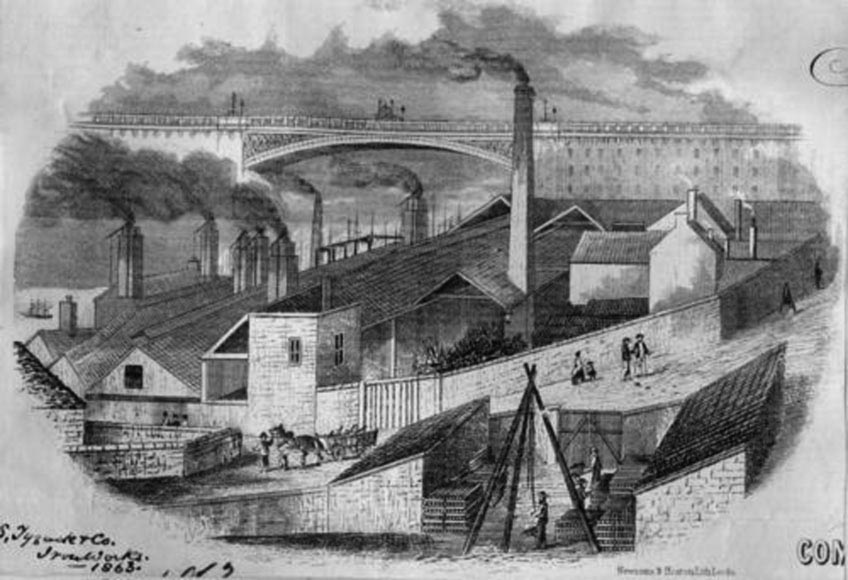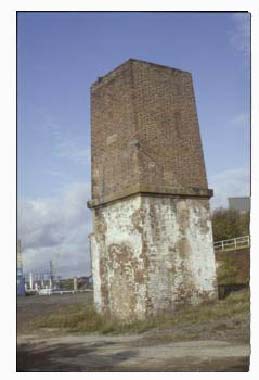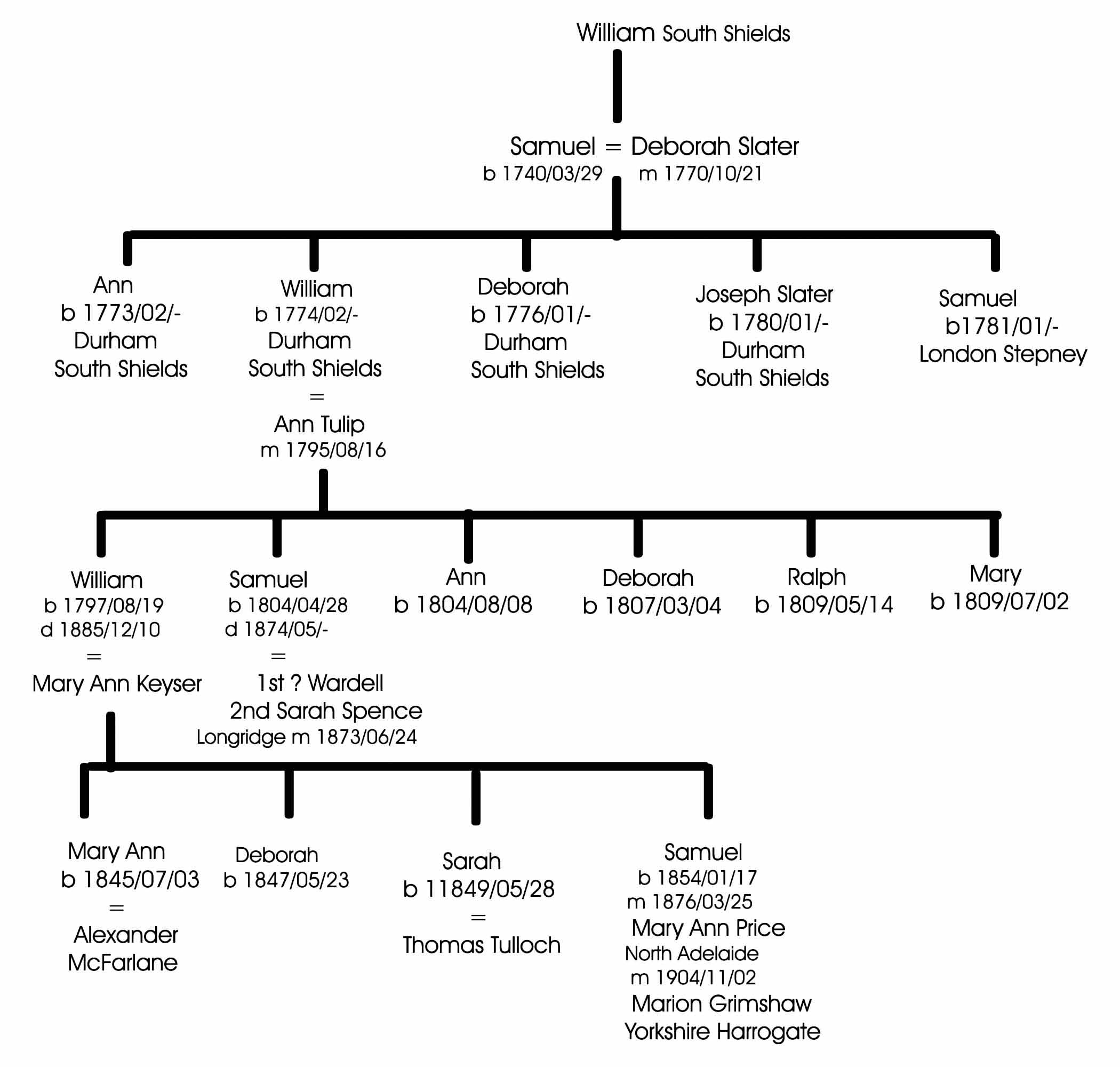But this story will follow the Samuel, born 1804 and also the William born 1797.
Samuel died a rich man. It has been a mystery how he started on his fortune. His father left no evidence of being wealthy nor did Ann Tulip his mother.
But buried in his will is a bequest to the sisters of his first wife. I cannot find her Christian name but her surname was Wardell. That was enough! Although I cannot link her for certain she appears to have come from a wealthy family. John Wardell, who was probably her grandfather, had married Jane Harrison. When they married there was a marriage settlement which included property:
“Dwelling houses, cottage and land at Eppleby as described with field names and areas in the deed Declaration of trust that in respect of copyhold lands at Blackwell and Whessoe in the Manor of Bondgate in Darlington and Whitburn in the Manor of Chester.”
Miss X Wardell came from Whitburn not far away.
There is a newspaper cutting about Samuel in the Sunderland Echo of 25th September 1979. However they appear to have got William mixed up with Samuel as they state that William became an Alderman of the borough whereas actually Samuel became an Alderman and it is unlikely that both did so. The article states that the Alderman served his time as a draper and then opened a grocer’s shop. In due course he bought Hendon Flour Mills and then Edmondsley Colliery. { From a local paper......."It is known that Edmondsley Colliery was initially called Wellington Pit and was owned by a Mr Tyzack, of Sunderland, in the 1850s. He gave his name to Tyzack Street, pronounced Tissack, as the mining village grew......"
In SAMUEL TYZACK’S will he was said to be of the Borough of Sunderland in the County of Durham and of Sowerby House in the County of York. He was called an Iron Manufacturer and Colliery Owner.
So Samuel owned the Colliery and the Ironworks!
 Ironworks in 1863.
Amongst numerous bequests Samuel left a considerable number to local asylums and hospitals. So this is probably the explanation of why the local Monkwearmouth hospital has a Tyzack Ward!
The Sunderland Local Studies Group says that Tyzack Park is a housing
estate, which was built on the site of Tyzack's Iron & Steel Works off Fulwell
Road - This probably accounts for the name.
Samuel also left money to his wife’s parents George and Sarah Wardell. He left them three thousand pounds each, a goodly sum in those days. He says it was in payment for his considerable obligation to them. Of course this may have referred to his first wife but it is also likely to relate to money which he perhaps got from them to enable him to acquire his businesses.
The interesting part is his bequest to his Brother and to his favourite Nephew!
“ I give to my dear Brother William Tyzack of Port Adelaide, South Australia, two hundred pounds a year paid quarterly for his life and also to his Son Samuel Tyzack my Nephew, until he attains the age of twenty five years, one hundred pounds a year to be paid quarterly during his minority to aid in providing for his reasonable requirements in clothing and sustenance and in furthering his interests in whatever calling or profession he may be in or placed in by or with the concurrence of his father, Sisters and my Trustees and Executors. And when the said Samuel Tyzack my Nephew shall be left Fatherless and has completed fully and satisfactorily his present engagements as an apprentice to Sea or any other engagement he may subsequently have entered into honourably and well to the satisfaction of my Trustees and Executors, my Trustees and Executors may if they see fit and desirable to do so in furtherance of his, my said Nephew’s interests and well being, place him in the Edmondsley Office or Monkwearmouth Ironworks in the Parish of Monkwearmouth, or in some department in the said Iron Works at Monkwearmouth, wherein he may have every reasonable and fair opportunity and facility to acquire a knowledge of the business practically and otherwise to fit and aid him in looking after his own and his partners interests therein. …………….. I give one sixth part of my share and interest in the Monkwearmouth Iron Works and stock debts and effects thereof to my said Nephew Samuel Tyzack, his heirs executors administrators and assigns on his attaining the age of twenty five years And subject to and charged as aforesaid and as hereinafter mentioned.”
Brother William became a gentleman shipwright. It is not clear why the epithet “gentleman” was added unless it indicated either his belonging to the Guild or his status as a freeholder. It should not be dismissed too quickly because there must have been some status or money in this family.
William was attracted to the idea of emigrating to Australia, probably for two reasons: one the background of the bank crash which occurred between 1836 -1839. In late 1836, the Bank of England concerned with inflation raised interest rates. As rates rose in England the US panicked. On May 10th 1837, the banks of New York suspended gold and silver payments for their notes! Investors panicked and scrambled for cash. By 1838 one third of the US work force was jobless, and those with jobs saw their wages fall 30-50%. On June 20, 1839, the Bank of England again raised the rate, now to 5½ per cent.
So in this gloomy environment William, who may have been by then without a job, could well have looked for pastures new. With the news as just described from America he is likely to have dismissed America as an option and with problems in his shipbuilding employment on the Tyne, at 43years of age, although no longer a callow youth, he took the plunge.
There was quite a bit going for Australia at the time. Britain was anxious to export its unemployed and when Mr T. F. Elliot became agent-general for emigration in 1837, he gave emigrants a lot of encouragement. As secretary for the Emigration Commission he had helped to collect and disseminate information on the British colonies. Now he resumed charge of general emigration, and in particular he chartered ships for assisted migrants going to Australia. Elliot persisted in protecting emigrants from the time of their recruitment in Britain until they found work in the colony. In 1831, the British Government had begun using the revenue it had raised from the sale of land in Australia to subsidize the migration for free settlement. In spite of the general transportation to Australia of anyone falling foul of the courts, South Australia, where William went, never accepted any convicts directly from England. The availability of free passages to Australia after 1832 was partly responsible for the widespread emigration. This was a time when emigration to Australia and America, was increasing at a phenomenal rate. In 1837, an additional scheme, devised by the Government of New South Wales, encouraged the immigration of skilled agricultural workers, unmarried women and mechanics. From 1837 this colonial bounty system was to supplement the British government system operated by Elliot. Between 1832 and 1835, John Broadfoot was slashing the passage money rates to Australia for the ships that he handled.
In 1836 the site for Adelaide was chosen by Colonel William Light beside the River Torrens as Australia's first free colony. In 1837 single-acre allotments were made, to holders of land orders and then by auction. In 1838 the flow to Australia increased. Between 1837 and 1846 assisted emigrants, greatly outnumbered the unassisted emigrants. In 1838 the first ballot for land was held at £1 per acre.
Anyway William arrived in South Australia on the 478 tons Warrior, on 17th April 1840 having sailed with Captain Beckett out of London.
The ship left London on 16th and Plymouth on 27th. The cargo was .....338 packages containing two steam engines and other merchandise, 235 deals and battens, 1 hhd. brandy, 133 hhds beer, 1 case 1 box books 1 gig, 14hhds 5 casks wine 12 brls. biscuit, 210 packages merchandise. There were several first class passengers and intermediate passengers, William being one of them, as he had paid his passage, also there were one hundred men women and children in the steerage. William was listed as "Tyrock" on the passenger list. There were 30 men, 29 Female and 38 children on the “Warrior” when they arrived in Southern Australia.....
But many others did the same. The emigration regulations were biased heavily in favour of single women aged between 18 and 30. So perhaps it was not surprising that Mary Ann Keyser had arrived in South Australia a few days earlier in March 1840 on the Orissa from Plymouth which she left in 1839 eighteen weeks earlier, but she had to stop off in Capetown. Her name is in the Register of Emigrant Labourers Applying for a Free Passage to South Australia 1836-1841. She was a domestic servant of Turnchapel, single, aged 28 years. In those days her friends might have thought she had been “left on the shelf!”
The 'ORISSA' was just 323 ton, a 3 mast barque built in 1832 in Dumbarton. William met Mary and they married on 9th September 1844 at Holy Trinity Church, North Terrace, Adelaide, the oldest church in South Australia. William and Mary had three daughters, Mary Ann, Deborah, Sarah and a son Samuel. She died 15th December, 1860 at Port Adelaide, South Australia.
The proclamation of the province of South Australia on the 28th December 1836 by the South Australian Company reaped a lot of potential immigrants. Many had been encouraged to opt for this new life in Australia. Agents of the Colonization Committee for South Australia toured villages selling the idea of emigration. From 1836 to 1840, 105 vessels brought a mixture of paying and free immigrants.
For these new South Australians flour was of the utmost importance. The settlers ate bread as their staple diet. By the early 1840s the construction of a flour mill in the city of Adelaide was an absolute necessity. Only two mills were there then. Speed was vital in dealing with South Australia's big harvest and the colonists' pressing needs. The expected harvest in 1841 was 'variously estimated at from 150,000 to 200,000 bushels', and the province's milling capacity was only 36,000 bushels.
Would-be millers arose to the challenge of making good the shortfall from 1841, so that by early February 1843 there were eight flour mills in Adelaide alone. The following decade saw a frenzy of speculation in flour mills in South Australia. By 1854 there were no fewer than sixty.
In 1844 William had four acres of wheat under cultivation. Later he built the first flour mill at Bowden.An Advert inserted by William:
"Argus 1st July 1903
Advert
Chickens Dying. - Bad feeding the cause,
Victorian Chicken Meal saves lives; try shilling bag. Tyzack 405 Bourks-st. "
Son Samuel became wealthy as a result of his uncle's will.. His first marriage was to Mary Ann Price 25th March 1876 in North Adelaide, his second to Marion Grimshaw 2nd November 1904 in Harrogate York. When he died he left a house with 92 acres a coal company and a shipping company. He also became a benefactor to Sunderland Football Club. His sister Mary Ann and her husband Alexander McFarlane visited him in 1894 as there is a post card still held by the family that was sent from London also a bottle, still in existence, blown by Alexander McFarlane at Southwick Bottle Works Sunderland on October 26th 1894.
Samuel was not put off by the voyage as he revisited Adelaide at the Christmas 1903. There is a photograph of him at that time with his sisters Mary Ann and Sarah. The local church is comparatively new. St. Paul's Church of England church. It is largely the result of the munificence of Mr. Samuel Tyzack, a former resident of Port Adelaide who went to reside in the United Kingdom. On this visit he found St. Paul's virtually in disrepair. "Why not build a new church?” he asked. The rector asked in return,” Where is the money to come from?" "I'll help you!," Mr. Tyzack responded. He did so to the extent of £4,000, and the foundation stone of the present church was laid on May 13, 1905, by Mrs. McFarlane, a sister of the donor. Mr. Samuel Tyzack was born at Port Adelaide in 1854, and was educated at St. Paul's day school, under the then Mr. Dallison and at St. Peter's College. He resided in his native town until the death of his uncle Alderman Samuel Tyzack, in 1874. On his arrival in England he interested himself in the firm of Samuel Tyzack & Co., in accordance with the will of his uncle. This firm was a well known iron founders. Afterwards he became associated with the shipping firm of Tyzack & Branfoot, the Well Line of Steamers, the Washington Coal Company, and the Edmondsley Coal Company, (which caused him some grief:
"The Hobart Mercury 15th May 1886.
Late on Wednesday night an attempt was made to blow up by dynamite the residence of Mr. Tyzack the manager of the South Medomsley colliery, Durham, where a strike exists, and where evictions took place recently. Mr. Tyzack and family were just retiring to rest when a loud report was heard and the whole front of the house was badley damaged. A canister of blasting gelatine with fuse attached was found. One cartridge containing 3oz. of gelatine had not exploded, otherwise the whole building would have been wrecked, and people killed. The police are using every effort to bring the perpetrators to justice.)
During his earlier years he lived in Sunderland EsplanadeDuring his later years he lived at his country home in Hertfordshire. He met Marion Grimshaw not long after he arrived home in England and married her on 2nd of November 1904 at Friend’s Meeting House Harrogate in the County of York and had three children. There are still many members of this family in England.
Mary Ann Price died 26th June 1903 and is buried in England and we presume there were no children from this 1st marriage as none are mentioned in his will.
There is a memorial at St Paul's it mentions Samuel's wife but spells her name as Mary Amy Tyzack, a mistake. |
 This image of the chimney base is all that remains of one of the Cookson sites in South Shields. South Shields, or at least East Holborn was where Cookson built his glassworks around 1739. Also on the Wear were the Wearmouth Crown Glass Works, from 1786 and the Southwick bottleworks, from 1846.
This image of the chimney base is all that remains of one of the Cookson sites in South Shields. South Shields, or at least East Holborn was where Cookson built his glassworks around 1739. Also on the Wear were the Wearmouth Crown Glass Works, from 1786 and the Southwick bottleworks, from 1846. 
